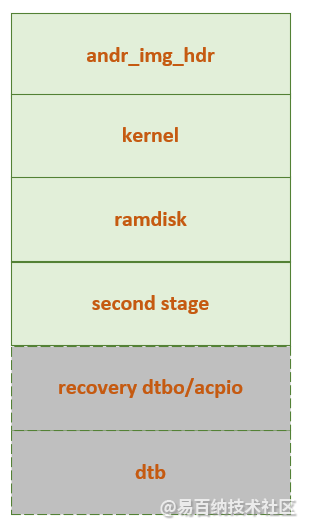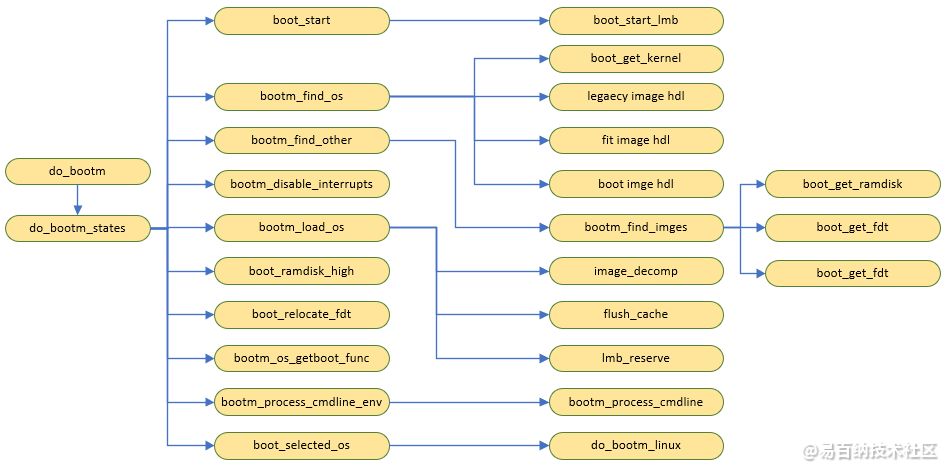U-boot启动流程[三]
U-boot启动流程[三]
本文基于以下软硬件假定:
架构:AARCH64
软件:U-boot 2021.10-rc1
1 Linux启动基础镜像
U-boot主要用于启动操作系统,以armv8架构下的linux为例,其启动时需要包含kernel、dtb和rootfs三部分。U-boot镜像都是以它们为基础制作的,因此在介绍U-boot镜像格式之前我们需要先了解一下它们的构成。
1.1 内核镜像
1.1.1 vmlinux镜像
linux内核编译完成后会在根目录生成原始的内核文件为vmlinux,使用readelf工具可看到其为elf文件格式:
hilbert@ubuntu:~/work/linux$ readelf -h vmlinux
ELF Header:
Magic: 7f 45 4c 46 02 01 01 00 00 00 00 00 00 00 00 00
Class: ELF64
Data: 2's complement, little endian
Version: 1 (current)
OS/ABI: UNIX - System V
ABI Version: 0
Type: DYN (Shared object file)
Machine: AArch64
Version: 0x1
Entry point address: 0xffff800010000000
Start of program headers: 64 (bytes into file)
Start of section headers: 13681696 (bytes into file)
Flags: 0x0
Size of this header: 64 (bytes)
Size of program headers: 56 (bytes)
Number of program headers: 3
Size of section headers: 64 (bytes)
Number of section headers: 29
Section header string table index: 28
- 1
- 2
- 3
- 4
- 5
- 6
- 7
- 8
- 9
- 10
- 11
- 12
- 13
- 14
- 15
- 16
- 17
- 18
- 19
- 20
- 21
由于uboot引导的镜像不能包含elf头,因此该镜像不能直接被uboot使用。
1.1.2 Image和zImage镜像
Image镜像是vlinux经过objcopy去头后生成的纯二进制文件,对于armv8架构其编译的Makefile如下
OBJCOPYFLAGS_Image := -O binary -R .note -R .note.gnu.build-id -R .comment –S (1)
targets := Image Image.bz2 Image.gz Image.lz4 Image.lzma Image.lzo
$(obj)/Image: vmlinux FORCE
$(call if_changed,objcopy) (2)
$(obj)/Image.bz2: $(obj)/Image FORCE
$(call if_changed,bzip2) (3)
$(obj)/Image.gz: $(obj)/Image FORCE
$(call if_changed,gzip) (4)
$(obj)/Image.lz4: $(obj)/Image FORCE
$(call if_changed,lz4) (5)
$(obj)/Image.lzma: $(obj)/Image FORCE
$(call if_changed,lzma) (6)
$(obj)/Image.lzo: $(obj)/Image FORCE
$(call if_changed,lzo) (7)
- 1
- 2
- 3
- 4
- 5
- 6
- 7
- 8
- 9
- 10
- 11
- 12
- 13
- 14
- 15
- 16
- 17
- 18
- 19
(1)objcopy命令使用的flag定义
(2)以vmlinux为原始文件,通过objcopy命令制作Image镜像。其命令可扩展如下:
aarch64-linux-gnu-objcopy -O binary -R .note -R .note.gnu.build-id -R .comment -S vmlinux Image
- 1
该命令会执行以下操作:
a –O binary:将输出二进制镜像,即会去掉elf头
b –R .note:-R选项表示去掉镜像中指定的section,如这里会去掉.note、.note.gnu.build-id和.comment段
c –S:去掉符号表和重定位信息,它与-R选项的功能类似,都是为了减小镜像的size
- 1
- 2
- 3
因此,执行该命令后生成的Image镜像是去掉elf头,去掉.note等无用的section,以及strip过的二进制镜像。它可以被uboot的booti命令直接启动。但若要使用bootm启动,则还需要将其进一步封装为后面介绍的uimage或bootimg镜像
(3 – 7)以Image为源文件,调用不同的压缩算法,对镜像进行压缩。若调用gzip命令,则可将其压缩为我们熟悉的zImage镜像。与Image一样,压缩后的镜像也是可以被booti直接启动,且经过封装以后可以被bootm启动的
- 1
1.2 设备树
设备树是设备树dts源文件经过编译后生成的,其目标文件为二进制格式的dtb文件。其示例编译命令如下:
dtc -I dts -O dtb -o example.dtb example.dts
- 1
(1) –I:指定输入文件格式
(2)–O:指定输出文件格式
(3)–o:指定输出文件名
- 1
- 2
- 3
设备树还支持dtb overlay机制,即可以向设备提供一个基础dtb和多个dtbo镜像,并在启动前将它们merge为最终的dtb。下面用一个例子来说明:
(1)基础dts文件base.dts内容如下:
/dts-v1/;
/ {
foo: foonode {
foo-property;
};
};
- 1
- 2
- 3
- 4
- 5
- 6
(2)dtbo源文件overlay.dts内容如下:
/dts-v1/;
/plugin/;
/ {
fragment@1 {
target = <&foo>;
__overlay__ {
overlay-1-property;
bar: barnode {
bar-property;
};
};
};
};
- 1
- 2
- 3
- 4
- 5
- 6
- 7
- 8
- 9
- 10
- 11
- 12
- 13
(3)分别使用以下命令编译dtb和dtbo
dtc -@ -I dts -O dtb -o base.dtb base.dts
dtc -@ -I dts -O dtb -o overlay.dtbo overlay.dts
- 1
- 2
(4)将dtbo merge到base dtb上
a 通过fit镜像包含和定义一个overlay,这种情况uboot会自动解析fit参数并执行merge操作
b 手动加载和apply overlay
- 1
- 2
(5)手动merge流程
a 设置base dtb和dtbo的地址
setenv fdtaddr 0x87f00000
setenv fdtovaddr 0x87fc0000
- 1
- 2
- 3
- 4
b 加载base dtb和dtbo
load ${devtype} ${bootpart} ${fdtaddr} ${bootdir}/base.dtb
load ${devtype} ${bootpart} ${fdtovaddr} ${bootdir}/overlay.dtbo
- 1
- 2
- 3
- 4
c 将base dtb设置为工作dtb
fdtaddr $fdtaddr
- 1
- 2
- 3
d 增大dtb的size,以使其可以容纳所有overlay
fdt resize 8192
- 1
- 2
- 3
e apply dtb overlay
fdt apply $fdtovadd
- 1
- 2
- 3
1.3 根文件系统
linux可以支持多种形式的根文件系统,如initrd、initramfs、基于磁盘的根文件系统等。站在启动镜像的角度看其实它们都是制作好的文件系统镜像,内核可以从特定的位置获取并挂载它们。以下是它们在启动时的基本特性:
(1)initrd
它是一种内存文件系统,需要由bootloader预先加载到内存中,并将其内存地址传递给内核。如uboot将initrd加载到地址$initrd_addr处,则bootm参数如下:
bootm $kernel_addr $initrd_addr $fdt_addr
- 1
(2)initramfs
initramfs也是一种内存文件系统,但与initrd不同,它是与内核打包在一起的。因此不需要通过额外的参数
(3)磁盘rootfs
磁盘根文件系统会被刷写到flash、mmc或disk的分区中,在内核启动时可在bootargs添加下面格式的参数,以指定根文件系统的位置
root=/dev/xxx
- 1
因此,以上这些rootfs只有initrd是需要uboot独立加载的,故只有当rootfs为initrd时,uboot镜像打包流程才需要在镜像打包时为其单独考虑
2 Uboot支持的镜像格式
2.1 Legacy uimage格式
uboot最先支持legacy uimage格式的镜像,它是在内核镜像基础上添加一个64字节header生成的。该header信息用于指定镜像的一些属性,如内核的类型、压缩算法类型、加载地址、运行地址、crc完整性校验值等。其格式如下:
typedef struct image_header {
uint32_t ih_magic; /* Image Header Magic Number */
uint32_t ih_hcrc; /* Image Header CRC Checksum */
uint32_t ih_time; /* Image Creation Timestamp */
uint32_t ih_size; /* Image Data Size */
uint32_t ih_load; /* Data Load Address */
uint32_t ih_ep; /* Entry Point Address */
uint32_t ih_dcrc; /* Image Data CRC Checksum */
uint8_t ih_os; /* Operating System */
uint8_t ih_arch; /* CPU architecture */
uint8_t ih_type; /* Image Type */
uint8_t ih_comp; /* Compression Type */
uint8_t ih_name[IH_NMLEN]; /* Image Name */
} image_header_t;
- 1
- 2
- 3
- 4
- 5
- 6
- 7
- 8
- 9
- 10
- 11
- 12
- 13
- 14
uboot的bootm命令会解析镜像头中的信息,并根据这些信息执行镜像校验、解压和启动等流程。以下是创建uImage的命令示例:
mkimage -A arm64 -O linux -C none -T kernel -a 0x80008000 -e 0x80008040 -n Linux_Image -d zImage uImage
- 1
但是它也有着一些缺点,如:
(1)加载流程比较繁琐,如需要分别加载内核、initrd和dtb
(2)启动参数较多,需要分别制定内核、initrd和dtb的地址
(3)在支持secure boot的系统中对secure boot的支持不足
- 1
- 2
- 3
为此,uboot又定义了一种新的镜像格式fit uimage,用于解决上述问
2.2 Fit uimage格式
Fit uimage是使用devicetree语法来定义uimage镜像描述信息以及启动时的各种属性,这些信息被写入一个后缀名为its的源文件中。以下是一个its文件的示例
/dts-v1/;
/ {
description = "Various kernels, ramdisks and FDT blobs";
#address-cells = <1>;
images {
kernel-1 {
description = "vanilla-2.6.23"; (1)
data = /incbin/("./vmlinux.bin.gz"); (2)
type = "kernel"; (3)
arch = "ppc"; (4)
os = "linux"; (5)
compression = "gzip"; (6)
load = <00000000>; (7)
entry = <00000000>; (8)
hash-1 {
algo = "md5"; (9)
};
hash-2 {
algo = "sha1";
};
};
kernel-2 {
description = "2.6.23-denx";
data = /incbin/("./2.6.23-denx.bin.gz");
type = "kernel";
arch = "ppc";
os = "linux";
compression = "gzip";
load = <00000000>;
entry = <00000000>;
hash-1 {
algo = "sha1";
};
};
kernel-3 {
description = "2.4.25-denx";
data = /incbin/("./2.4.25-denx.bin.gz");
type = "kernel";
arch = "ppc";
os = "linux";
compression = "gzip";
load = <00000000>;
entry = <00000000>;
hash-1 {
algo = "md5";
};
};
ramdisk-1 {
description = "eldk-4.2-ramdisk";
data = /incbin/("./eldk-4.2-ramdisk");
type = "ramdisk";
arch = "ppc";
os = "linux";
compression = "gzip";
load = <00000000>;
entry = <00000000>;
hash-1 {
algo = "sha1";
};
};
ramdisk-2 {
description = "eldk-3.1-ramdisk";
data = /incbin/("./eldk-3.1-ramdisk");
type = "ramdisk";
arch = "ppc";
os = "linux";
compression = "gzip";
load = <00000000>;
entry = <00000000>;
hash-1 {
algo = "crc32";
};
};
fdt-1 {
description = "tqm5200-fdt";
data = /incbin/("./tqm5200.dtb");
type = "flat_dt";
arch = "ppc";
compression = "none";
hash-1 {
algo = "crc32";
};
};
fdt-2 {
description = "tqm5200s-fdt";
data = /incbin/("./tqm5200s.dtb");
type = "flat_dt";
arch = "ppc";
compression = "none";
load = <00700000>;
hash-1 {
algo = "sha1";
};
};
};
configurations {
default = "config-1";
config-1 {
description = "tqm5200 vanilla-2.6.23 configuration";
kernel = "kernel-1";
ramdisk = "ramdisk-1";
fdt = "fdt-1";
};
config-2 {
description = "tqm5200s denx-2.6.23 configuration";
kernel = "kernel-2";
ramdisk = "ramdisk-1";
fdt = "fdt-2";
};
config-3 {
description = "tqm5200s denx-2.4.25 configuration";
kernel = "kernel-3";
ramdisk = "ramdisk-2";
};
};
};
- 1
- 2
- 3
- 4
- 5
- 6
- 7
- 8
- 9
- 10
- 11
- 12
- 13
- 14
- 15
- 16
- 17
- 18
- 19
- 20
- 21
- 22
- 23
- 24
- 25
- 26
- 27
- 28
- 29
- 30
- 31
- 32
- 33
- 34
- 35
- 36
- 37
- 38
- 39
- 40
- 41
- 42
- 43
- 44
- 45
- 46
- 47
- 48
- 49
- 50
- 51
- 52
- 53
- 54
- 55
- 56
- 57
- 58
- 59
- 60
- 61
- 62
- 63
- 64
- 65
- 66
- 67
- 68
- 69
- 70
- 71
- 72
- 73
- 74
- 75
- 76
- 77
- 78
- 79
- 80
- 81
- 82
- 83
- 84
- 85
- 86
- 87
- 88
- 89
- 90
- 91
- 92
- 93
- 94
- 95
- 96
- 97
- 98
- 99
- 100
- 101
- 102
- 103
- 104
- 105
- 106
- 107
- 108
- 109
- 110
- 111
- 112
- 113
- 114
- 115
- 116
- 117
- 118
- 119
- 120
- 121
- 122
- 123
- 124
- 125
- 126
- 127
- 128
- 129
它包含
images和configurations两个顶级节点,images指定该its文件会包含哪些镜像,以及这些镜像的属性信息。configurations用于定义一系列镜像组合信息,如在本例中包含了config-1、config-2和config-3三种镜像组合方式。Its使用default属性指定启动时默认采用的配置信息,若启动时不希望使用默认配置,则可通过在启动参数中动态指定配置序号。下面我们通过kernel-1节点看下image属性的含义:
1. 镜像的描述信息
2. 镜像文件的路径
3. 镜像类型,如kernel、ramdisk或fdt
4. 支持的架构
5. 支持的操作系统
6. 其使用的压缩算法
7. 加载地址
8. 运行地址
9. 完整性校验使用的hash算法
- 1
- 2
- 3
- 4
- 5
- 6
- 7
- 8
- 9
configurations的属性比较简单,就是指定某个配置下使用哪一个kernel、dtb和ramdisk镜像。Fit image除了支持完整性校验外,还可支持hash算法 + 非对称算法的secure boot方案,如以下例子:
kernel {
data = /incbin/("test-kernel.bin");
type = "kernel_noload";
arch = "sandbox";
os = "linux";
compression = "none";
load = <0x4>;
entry = <0x8>;
kernel-version = <1>;
signature {
algo = "sha1,rsa2048"; (1)
key-name-hint = "dev"; (2)
};
};
- 1
- 2
- 3
- 4
- 5
- 6
- 7
- 8
- 9
- 10
- 11
- 12
- 13
- 14
- (1)指定sha1为secure boot签名使用的hash算法,rsa2048为其使用的签名算法
- (2)可能使用的验签密钥名
与设备树类似,its文件可以通过mkimage和dtc编译生成itb文件。镜像生成方式如下:
mkimage -f xxx.its xxx.itb
- 1
xxx.itb文件可以直接传给uboot,并通过bootm命令执行,如xxx.itb被加载到0x80000000,则其命令如下:
bootm 0x80000000
- 1
若需要选择非默认的镜像配置,则可通过指定配置序号实现,例如:
bootm 0x80000000#config@2
- 1
2.3 Boot image格式
boot image是android定义的启动镜像格式,到目前为止一共定义了三个版本(v0 – v2),其中v0版本包含andr_img_hdr、kernel、ramdisk和second stage,v1版本增加了recovery dtbo/acpio,v2版本又增加了dtb。在这些镜像中second stage是可选的,而recovery dtbo只有在使用recovery分区的非AB系统中才需要,且它们都需要page对齐(通常为2k)。以下是boot image镜像的基本格式:

andr_img_hdr镜像头用于描述这些镜像的信息,如其长度、加载地址等,其定义如下:
struct andr_img_hdr {
/* Must be ANDR_BOOT_MAGIC. */
char magic[ANDR_BOOT_MAGIC_SIZE];
u32 kernel_size; /* size in bytes */
u32 kernel_addr; /* physical load addr */
u32 ramdisk_size; /* size in bytes */
u32 ramdisk_addr; /* physical load addr */
u32 second_size; /* size in bytes */
u32 second_addr; /* physical load addr */
u32 tags_addr; /* physical addr for kernel tags */
u32 page_size; /* flash page size we assume */
u32 header_version;
u32 os_version;
char name[ANDR_BOOT_NAME_SIZE]; /* asciiz product name */
char cmdline[ANDR_BOOT_ARGS_SIZE];
u32 id[8]; /* timestamp / checksum / sha1 / etc */
char extra_cmdline[ANDR_BOOT_EXTRA_ARGS_SIZE];
u32 recovery_dtbo_size; /* size in bytes for recovery DTBO/ACPIO image */
u64 recovery_dtbo_offset; /* offset to recovery dtbo/acpio in boot image */
u32 header_size;
u32 dtb_size; /* size in bytes for DTB image */
u64 dtb_addr; /* physical load address for DTB image */
} __attribute__((packed));
- 1
- 2
- 3
- 4
- 5
- 6
- 7
- 8
- 9
- 10
- 11
- 12
- 13
- 14
- 15
- 16
- 17
- 18
- 19
- 20
- 21
- 22
- 23
- 24
- 25
- 26
- 27
- 28
- 29
- 30
- 31
- 32
- 33
- 34
可以使用mkbootimg.py脚本制作boot image镜像,该脚本参数比较简单,就是指定与镜像头中定义的相关参数。例如:
mkbootimg.py \
--base aaa \
--kernel kernel/arch/arm64/boot/Image.gz \
--kernel_offset bbb \
--second kernel/arch/arm64/boot/ccc.dtb \
--second_offset ddd \
--board test_board \
-o boot.img
- 1
- 2
- 3
- 4
- 5
- 6
- 7
- 8
3 bootm流程
bootm是uboot用于启动操作系统的命令,它的主要流程包括根据镜像头获取镜像信息,解压镜像,以及启动操作系统。以下为其主要执行流程:

上面的流程都比较直观,有兴趣可以对照代码自行分析一下
- 分享
- 举报
 暂无数据
暂无数据-
浏览量:1674次2023-12-06 12:30:38
-
浏览量:1570次2023-12-04 13:11:50
-
浏览量:1263次2024-03-29 11:02:56
-
浏览量:1873次2024-03-29 11:08:20
-
浏览量:1241次2023-12-01 12:14:35
-
浏览量:2215次2020-03-30 17:12:36
-
浏览量:1709次2023-03-28 19:19:22
-
浏览量:6500次2020-12-19 11:23:50
-
浏览量:1784次2023-03-28 19:37:31
-
浏览量:3824次2017-11-20 11:05:33
-
浏览量:4271次2023-04-03 16:45:01
-
浏览量:3431次2024-03-16 11:19:01
-
浏览量:1455次2023-08-19 14:25:08
-
浏览量:3359次2023-03-17 18:38:40
-
浏览量:2179次2023-04-03 15:51:40
-
浏览量:2048次2023-04-03 15:28:29
-
浏览量:5431次2020-09-30 15:05:19
-
2023-11-28 10:58:59
-
2020-08-03 19:07:53
-
广告/SPAM
-
恶意灌水
-
违规内容
-
文不对题
-
重复发帖
Hilbert





 微信支付
微信支付举报类型
- 内容涉黄/赌/毒
- 内容侵权/抄袭
- 政治相关
- 涉嫌广告
- 侮辱谩骂
- 其他
详细说明


![U-boot启动流程[三]](https://ebaina.oss-cn-hangzhou.aliyuncs.com/res/images/202206/30/20220630-141043-801.png)
 微信扫码分享
微信扫码分享 QQ好友
QQ好友






